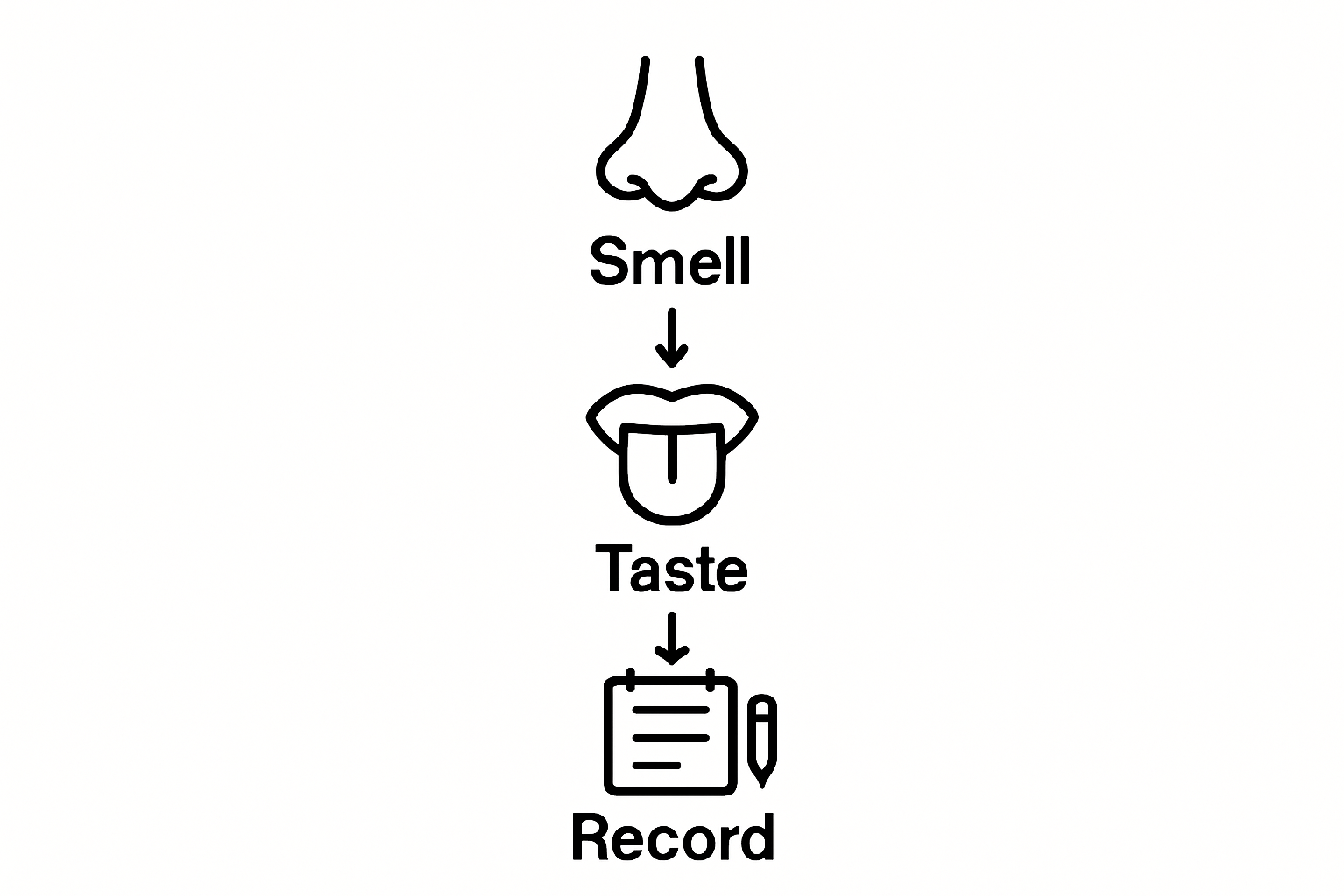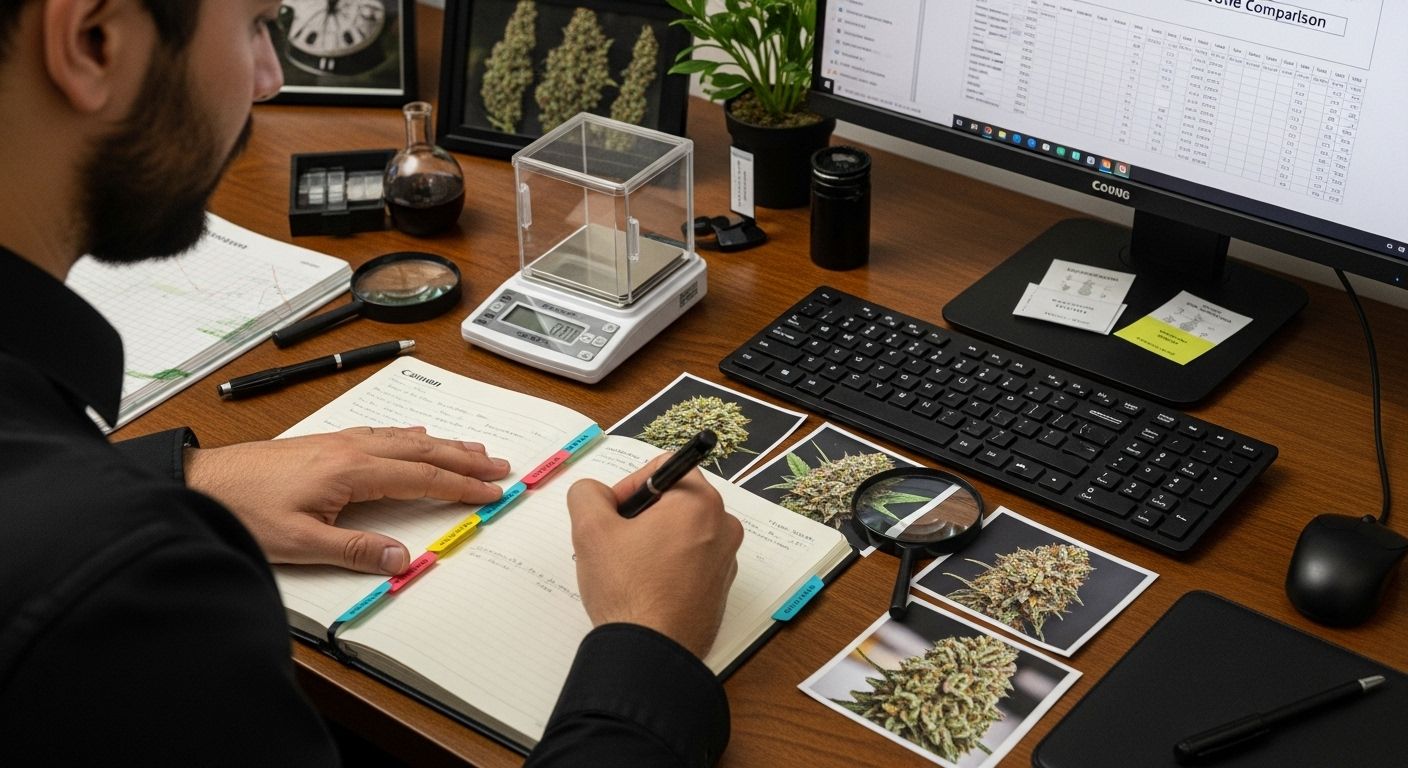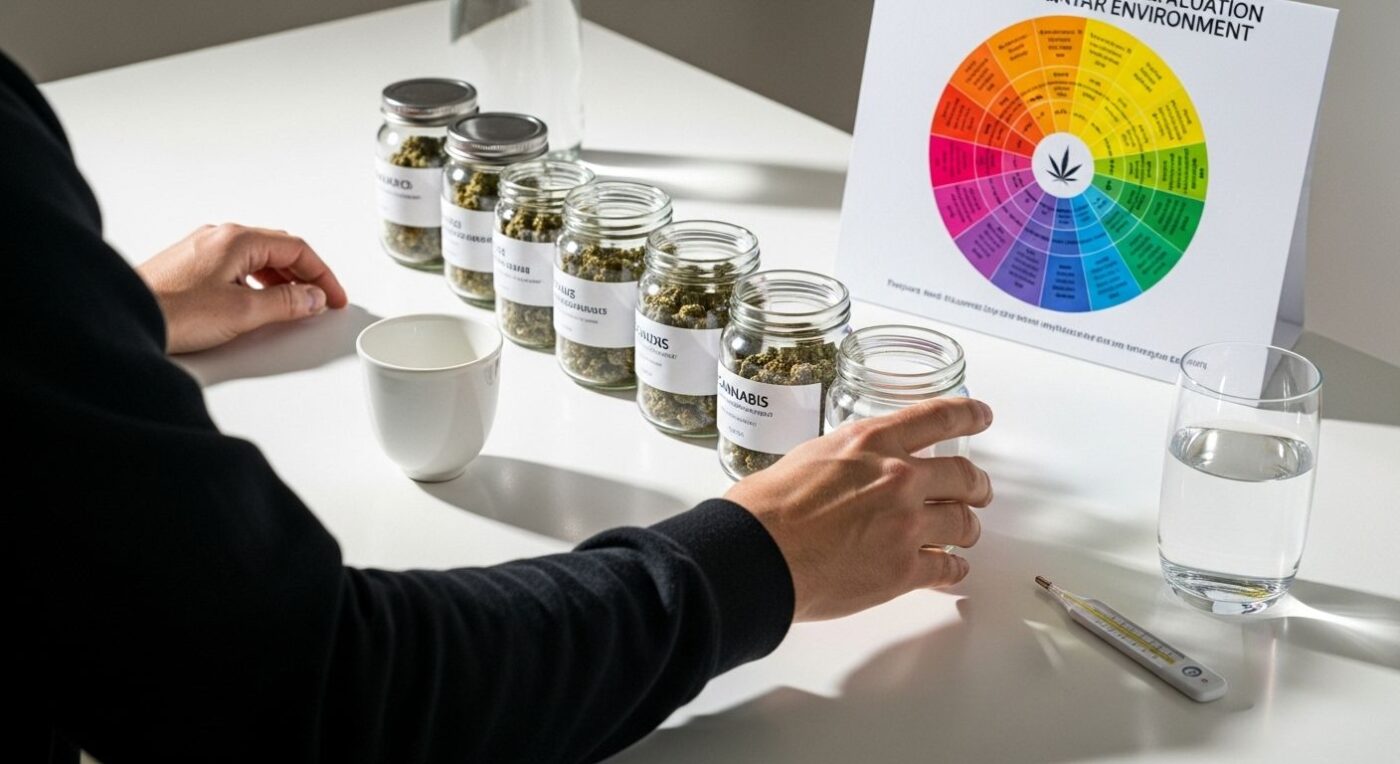Blog Posts
How to Evaluate Flavor Profiles for Premium Cannabis Products
Serious cannabis connoisseurs know that tasting weed is about more than just lighting up. Studies show untrained consumers can reliably distinguish cannabis aromas when distractions are controlled. Surprised? Most people think flavor evaluation is a free-for-all, but the real secret is a scientific approach and methodical prep. The right setup lets you unlock layers of aroma and taste that you never even noticed before.
Table of Contents
- Step 1: Prepare Your Evaluation Environment
- Step 2: Gather Flavor Profile Resources
- Step 3: Conduct Scent And Taste Tests
- Step 4: Document Your Findings Thoroughly
- Step 5: Compare And Analyze Flavor Profiles
- Step 6: Share And Validate Your Evaluations
Quick Summary
| Key Point | Explanation |
|---|---|
| 1. Create a Controlled Environment | Choose a neutral space with consistent temperature and minimal odors for accurate sensory evaluation. |
| 2. Gather Essential Tools and Resources | Assemble reference materials like flavor wheels and recording sheets to document sensory findings systematically. |
| 3. Conduct Methodical Testing | Perform scent and taste tests with a structured approach, allowing for nuanced observations and thorough documentation. |
| 4. Document Findings Systematically | Use standardized templates for recording sensory profiles to convert subjective experiences into objective insights. |
| 5. Share and Validate Evaluations | Engage with communities for feedback to refine your understanding and contribute to collective cannabis flavor knowledge. |
Step 1: Prepare Your Evaluation Environment
Evaluating cannabis flavor profiles requires a meticulously prepared environment that allows for accurate sensory assessment. Your goal is to create a controlled setting that minimizes external interference and maximizes your ability to detect subtle aromatic and flavor nuances.
Begin by selecting a neutral space with consistent temperature and minimal competing odors. A clean, well-ventilated room away from kitchen areas, active cooking spaces, or strong ambient fragrances will provide the most reliable evaluation conditions. Avoid areas with recent perfume or cleaning product usage, as these can dramatically impact your sensory perception.
Prepare your personal sensory toolkit before starting the evaluation. You will need several critical items to ensure a comprehensive assessment:
- Clean, white ceramic tasting cups or glass containers
- Neutral palate cleansers like room temperature water
- Unscented white paper for noting observations
- Optional: Flavor wheel or reference chart for systematic documentation
Personal preparation is equally important. Avoid consuming strong foods or beverages like coffee, spicy dishes, or tobacco products for at least two hours before your evaluation. These can compromise your taste and smell receptors, creating inaccurate flavor profile perceptions. According to research published in PLoS One, untrained consumers can reliably distinguish between cannabis strain aromas when evaluation conditions are carefully controlled.
Wear clean, unscented clothing and ensure you are well-rested. Sensory fatigue can develop quickly, so plan to conduct your evaluation during times when you feel alert and focused. If possible, conduct initial assessments in the morning when your sensory capabilities are typically at their peak.
A critical aspect of preparing your evaluation environment involves creating a consistent baseline. This means maintaining room temperature around 68-72 degrees Fahrenheit and minimizing external noise or visual distractions. Natural, soft lighting helps prevent eye strain and supports a calm, concentrated atmosphere conducive to precise sensory analysis.
Step 2: Gather Flavor Profile Resources
Successful cannabis flavor profile evaluation requires strategic resource gathering that goes beyond simple collection. Think of this step as assembling a comprehensive sensory investigation toolkit designed to provide nuanced insights into the complex world of cannabis aromatics and taste experiences.
Start by acquiring authoritative reference materials that will serve as your foundational guides. Professional flavor wheels specifically designed for cannabis provide structured frameworks for identifying and categorizing sensory characteristics. These visual tools transform subjective experiences into systematic observations, allowing you to document and compare flavor profiles with precision. Explore our guide on terpenes to understand the chemical foundations of these aromatic profiles.
Your resource collection should include several key documentation tools:
- Detailed flavor recording sheets
- High-quality magnifying glass for visual strain examination
- Neutral ceramic or glass containers for controlled sample storage
- Digital scale capable of measuring small cannabis quantities
- Temperature and humidity tracking instruments
Securing authentic, laboratory-verified terpene profile documentation becomes crucial for serious evaluators. According to research published in PMC, volatile compounds beyond primary terpenes significantly contribute to cannabis’s aromatic complexity. Professional cultivators and testing laboratories often provide comprehensive chemical analysis reports that detail exact terpene compositions, offering invaluable reference points for your evaluation.
Consider developing relationships with reputable cannabis testing facilities or dispensaries that provide detailed chemical analysis. These professional resources can offer insights into strain-specific flavor characteristics that go far beyond casual observations.
Below is a table summarizing the essential tools and resources required for premium cannabis flavor profile evaluation, along with their main purposes according to the article content.
| Tool/Resource | Purpose |
|---|---|
| Clean white ceramic cups or glass containers | Provide a neutral vessel for sample assessment |
| Neutral palate cleansers (water) | Reset taste receptors between samples |
| Unscented white paper | Take clear sensory notes without interference |
| Flavor wheel or reference chart (optional) | Guide structured documentation of flavor and aromas |
| Flavor recording sheets | Systematically document scent and taste observations |
| High-quality magnifying glass | Visually examine strain features |
| Digital scale | Accurately measure cannabis sample quantities |
| Temperature/humidity tracking instruments | Monitor environmental conditions for consistency |
| Laboratory terpene profile documentation | Reference chemical composition for precise analysis |
Step 3: Conduct Scent and Taste Tests
Conducting precise scent and taste tests represents the core of cannabis flavor profile evaluation. Systematic assessment transforms subjective experiences into objective insights, allowing you to decode the complex sensory landscape of premium cannabis products.
Begin with the olfactory examination, which requires a deliberate and methodical approach. Gently break or grind a small sample without crushing its structural integrity. Hold the sample approximately two inches from your nose and take short, controlled inhalations. Initial sniffs should be light and exploratory, allowing your olfactory receptors to detect nuanced aromatic compounds without overwhelming them.
Your scent evaluation should capture multiple dimensions:
- Initial top notes (immediate impressions)
- Mid-range aromatic characteristics
- Lingering background scent profiles
- Intensity and complexity of the aroma
Transition from scent to taste testing requires careful preparation. According to research published in NCBI, professional sensory panels employ specific techniques to minimize sensory fatigue. Allow a brief palate reset using room temperature water between different samples. When tasting, use small, controlled quantities that permit comprehensive flavor assessment without overwhelming your sensory capabilities.
Pay attention to flavor progression. Premium cannabis products exhibit complex taste experiences that evolve from initial contact through aftertaste.
Note how flavors transform across different stages of interaction. Some evaluators recommend using a standardized tasting sequence: initial flavor impression, mid-palate development, and residual taste characteristics.
Document your observations systematically using your prepared recording sheets. Assign numerical ratings or descriptive annotations that capture the subtle variations in scent and taste. Consistency in your evaluation method ensures reproducible results and allows for meaningful comparisons across different cannabis samples.

Step 4: Document Your Findings Thoroughly
Documenting cannabis flavor profile findings transforms subjective sensory experiences into structured, actionable insights. Systematic documentation is the bridge between personal perception and scientific understanding, creating a comprehensive record that allows for precise comparative analysis.
Begin by developing a standardized evaluation template that captures multiple sensory dimensions. Your documentation should include detailed sections for scent characteristics, taste progression, aromatic intensity, and overall flavor complexity. Use consistent rating scales that allow for objective measurement across different cannabis samples. This might involve numerical ratings from 1-10 or standardized descriptive language that provides clear, repeatable assessment criteria.
Your documentation toolkit should include:
- High-quality waterproof recording sheets
- Refillable digital or physical notebook
- Color-coded marking system for different evaluation aspects
- Calibrated scoring mechanisms
- Digital backup options for preservation
Photographic documentation adds significant value to your flavor profile evaluation. Capture close-up images of the cannabis sample, noting its visual characteristics such as trichome density, color variations, and structural integrity. These visual records complement your written observations, providing a comprehensive sensory profile that goes beyond immediate taste and scent impressions.
According to research published in NCBI, integrating quantitative and qualitative documentation methods enhances the reliability of sensory assessments. Consider creating a personal flavor profile database that allows you to track and compare different cannabis samples over time. This approach transforms individual evaluations into a robust, evolving reference system that grows more sophisticated with each new assessment.
Finalize your documentation by synthesizing your detailed notes into concise, clear summaries. Look for patterns, unique characteristics, and distinguishing flavor elements that define each cannabis sample’s distinctive profile. Your goal is to create a record that is both scientifically rigorous and personally insightful.
The following table provides an overview of the main steps for evaluating cannabis flavor profiles, including the key outcome and difficulty level for each stage.
| Step | Key Outcome | Difficulty Level |
|---|---|---|
| Prepare Evaluation Environment | Controlled, neutral space for accurate sensing | Easy |
| Gather Flavor Profile Resources | Comprehensive toolkit for systematic evaluation | Easy |
| Conduct Scent and Taste Tests | Objective observations of aroma and taste reactions | Moderate |
| Document Findings Thoroughly | Consistent, detailed records for reliable analysis | Moderate |
| Compare and Analyze Flavor Profiles | Nuanced understanding of aroma and taste complexity | Advanced |
| Share and Validate Your Evaluations | Collective refinement of sensory analysis | Moderate |
Step 5: Compare and Analyze Flavor Profiles
Comparing and analyzing flavor profiles transforms individual sensory experiences into a comprehensive understanding of cannabis complexity. This critical step bridges personal perception with systematic evaluation, allowing you to develop nuanced insights that go beyond superficial taste impressions.
Begin by organizing your documented findings from previous evaluations into a structured comparative framework. Create a master reference chart that allows side-by-side comparisons of different cannabis samples, highlighting distinctive aromatic and flavor characteristics. Learn more about our flavor exploration techniques to enhance your analytical approach.
Your comparative analysis should focus on several key dimensions:
- Terpene profile similarities and differences
- Aromatic intensity variations
- Flavor progression complexity
- Subtle nuanced characteristics
- Overall sensory experience consistency
According to research published in PubMed, professional sensory evaluations reveal that cannabis strains form distinct clusters based on their aromatic profiles. Leverage this insight by developing a personal classification system that moves beyond generic descriptors. Look for interconnected flavor notes, trace subtle molecular variations, and understand how different cultivation techniques influence sensory experiences.
Advanced comparative analysis requires developing a sophisticated palate and maintaining meticulous documentation. Cross-reference your flavor profile evaluations with available chemical analysis reports when possible. Pay special attention to how environmental factors, curing techniques, and genetic variations contribute to flavor complexity.
Finalize your analysis by synthesizing your observations into comprehensive flavor profile narratives. The goal is not just to describe what you experience, but to understand the intricate chemical and sensory interactions that create unique cannabis flavor experiences.
 Treat each evaluation as a learning opportunity, continuously refining your sensory perception and analytical skills.
Treat each evaluation as a learning opportunity, continuously refining your sensory perception and analytical skills.
Step 6: Share and Validate Your Evaluations
Sharing and validating your cannabis flavor profile evaluations transforms individual experiences into collective knowledge. This critical step elevates your sensory analysis from personal exploration to collaborative research, creating opportunities for deeper understanding and refined expertise.
Begin by selecting appropriate platforms for sharing your findings. Online cannabis enthusiast forums, professional tasting communities, and specialized social networks provide venues for constructive feedback. Presentation matters significantly when communicating your evaluations. Craft clear, concise descriptions that highlight your methodology, sensory observations, and unique insights. Explore our collaboration techniques to enhance your sharing strategy.
Your sharing toolkit should include:
- Detailed flavor profile documentation
- High-resolution sample photographs
- Systematic evaluation notes
- Chemical profile references
- Digital presentation formats
According to research published in PubMed, consumer perceptions of cannabis strains form distinct clusters based on aromatic profiles. Leverage this insight by seeking feedback from diverse experienced evaluators. Engage with communities that appreciate nuanced sensory analysis, inviting constructive critique and alternative perspectives.
Validation requires openness to different interpretations and a willingness to refine your approach. Approach shared evaluations as collaborative learning opportunities. Compare your findings with established flavor wheels, chemical analysis reports, and expert assessments. Look for convergence points and areas of divergence that can expand your understanding.
Remember that validation is an ongoing process. Each shared evaluation contributes to a growing collective knowledge base about cannabis flavor complexity. Develop a personal archiving system that allows you to track your evaluations’ evolution, noting how external feedback and continued learning reshape your sensory perception over time.
Elevate Your Flavor Discovery With Premium Cannabis Extracts
Struggling to find cannabis products that truly deliver on sophisticated flavor and aroma? You have learned how critical it is to control every detail of your evaluation environment and document each sensory note. But reaching the next level of cannabis tasting requires not just the right method, but also access to extracts crafted for real connoisseurs. If you are ready to experience the full spectrum of nuanced taste profiles described in your evaluations, let Official Coldfire Store help you go further. Explore more flavor insights on our Blog Posts to deepen your expertise.

Experience the difference of true artisanal quality by choosing from our collection of rich, full-spectrum extracts and curated concentrates. Our detailed product descriptions highlight exact terpenes, extraction methods, and flavor notes so you can match your findings to our exclusive offerings. Act now and start your next flavor evaluation with products designed for excellence. Discover the Official Coldfire Store experience at https://officialcoldfirestore.com and transform your sensory journey.
Frequently Asked Questions
How can I prepare my environment for evaluating cannabis flavor profiles?
To prepare your evaluation environment, choose a neutral, well-ventilated space away from strong odors, maintain a consistent temperature, and minimize distractions. Clean and unscented surroundings are essential for accurate sensory assessment.
What tools do I need for a cannabis flavor evaluation?
Essential tools include clean white ceramic tasting cups or glass containers, neutral palate cleansers like room temperature water, unscented paper for notes, and potentially a flavor wheel or reference chart for systematic documentation.
What is the process for conducting scent and taste tests on cannabis?
Start by gently breaking or grinding a cannabis sample, then conduct a thorough olfactory examination by inhaling short, controlled sniffs. Follow this with taste testing using small amounts to detect flavor progression and note the overall taste experience.
How can I document my cannabis flavor evaluations effectively?
Utilize a standardized evaluation template that includes sections for scent characteristics, taste progression, and complexity. Ensure your documentation is clear and consistent, using numerical ratings or descriptive language, and consider photographic documentation for additional context.
Recommended
Article generated by BabyLoveGrowth

